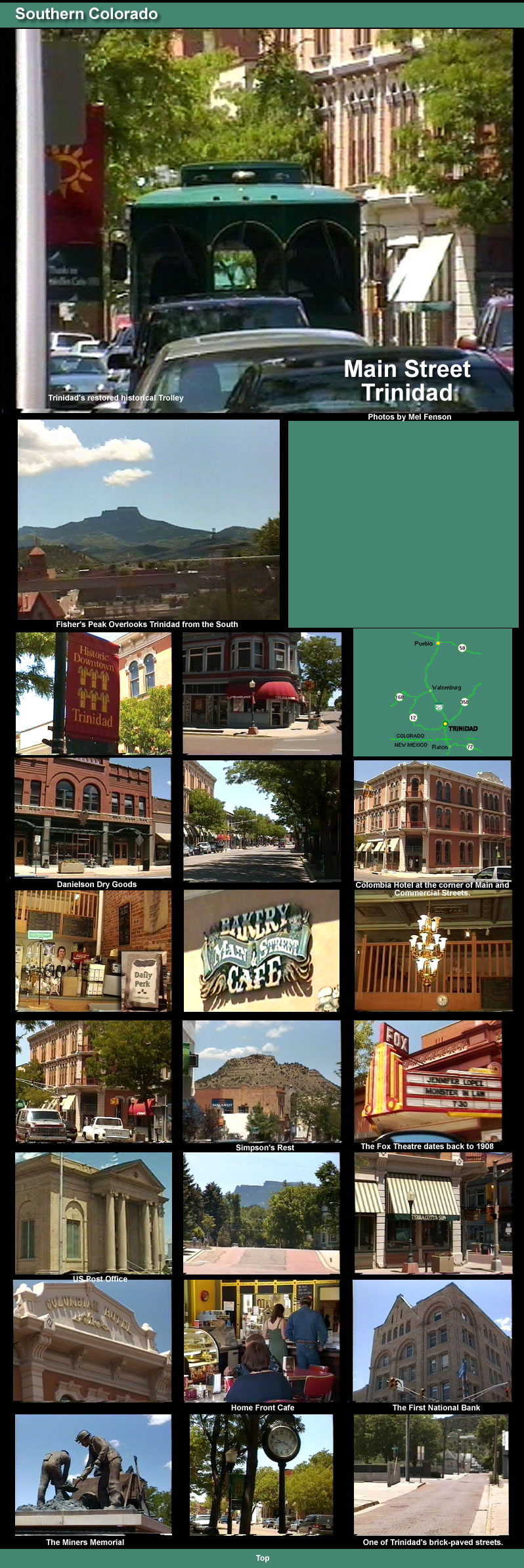

The town is bordered to the west by the awe-inspiring, Sangre de Cristo Mountain Range, whose peaks reach up to 14,000 feet. To the northwest of Trinidad are the 13,000 foot Spanish Peaks. The El Rio de Las Animas Perdidas en Purgatorio (the river of lost souls in Purgatory), also know as the Purgatoire River, flows through the center of Trinidad.
Trinidad lies along what was the old Santa Fe Trail, on the Colorado side of the Raton Pass which rises from Raton, New Mexico. The Santa Fe Trail was first traveled in 1821, when William Becknell, a young entrepreneur made a trip hauling merchandise from Independence, Missouri to Santa Fe, New Mexico. Evidence of the trail is apparent, even today, in the tracks left by wagon trains as they made their way across the plains passing by Trinidad and stopping there to rest and water their horses, oxen and cattle, before crossing over Raton Pass.
Originally Ute territory, Trinidad has a rich history and a colorful past. In the early 1860's, Trinidad was originally an unnamed campsite, at the base of Fisher's Peak, a basalt-capped mesa of volcanic origin that jutted out from the surrounding mesa. Traders from New Mexico, who had crossed over Raton Pass, stopped to rest there, while bringing supplies to Denver.
Twelve families became the first settlers in Trinidad’s fertile valley in 1862. Subsequently, with a population 2500, Trinidad, which had developed into the Victorian jewel of southern Colorado, was officially incorporated in 1876, a few months before Colorado gained statehood.
Trinidad's rich history was shaped by the Spaniards, French explorers, scouts, mountain men, trappers and traders who passed through the town. A well known Trinidad landmark, Simpson’s Rest, is named after, one of those pioneers, George S. Simpson, who was a famous scout, trader, and explorer. Legend has it that Simpson was riding along the banks of the Purgatoire River, when he was confronted by warring Ute Indians. He escaped harm, when he fled up a nearby butte and hid inside one of its natural vertical crevices.
Coal mining and cattle ranching drew families from many nationalities - Jewish, Italian, Polish, Slavic, German and Irish and many Trinidad families have origins dating back to the old Spanish settlers that originally settled Santa Fe and Albuquerque.
Trinidad's colorful history includes famous western names, such as Bat Masterson, who was the town Marshall in the 1880's and his friend and gambling buddy, Doc Holiday. Another well known personality from the old west, Wyatt Earp, drove the stage between Trinidad and Box Springs, New Mexico. Other historical names, who passed through the Trinidad area, include, Charley Goodnight and Oliver Loving, who established the Goodnight-Loving Trail, over which thousands of cattle were herded from Texas to the Rockies.
The advent of in 1878 of the Atcheson-Topeka and Santa Fe railroads brought an end to commerce and cattle herding on the Santa Fe Trail. The coming of the railroads stimulated the development of immense coal resources found in the Trinidad area. Colorado Fuel and Iron in Pueblo owned and mined most of the coal in the area. Today all of the coal mining operations have ceased but natural gas is still being extracted from this mineral rich area.
By the turn of the Century Trinidad’s population had grown to almost 9,000 and Las Animas County’s population reached close to 32,000 residents.
Today Trinidad, a town that had been mainly dependent on the local coal mining industry, has turned to service-based businesses and the city is prospering. Many old store fronts, that only a few years ago were closed and boarded up, are now being renovated and restored to provide space for new businesses that are springing up. An industrial park just north of town is also attracting new enterprises.
 |
|